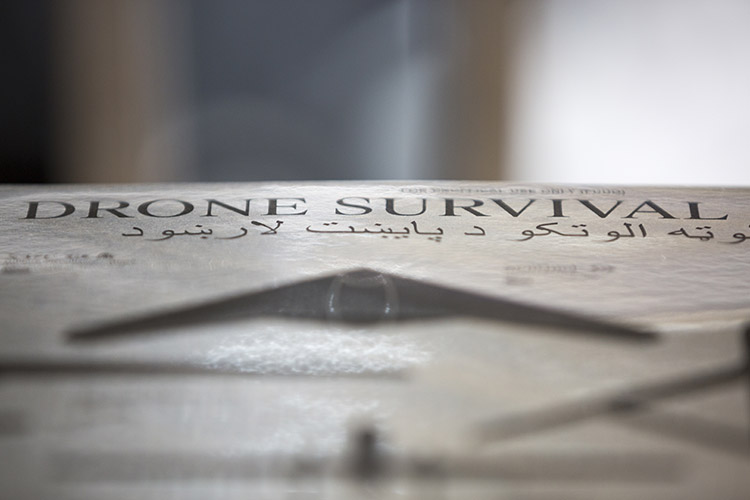* 1977 Gouda, NL, lives and works in Amsterdam, NL
Drone Survival Guide
2013, poster
A Study Into 21st Century Drone Acoustics
2015, in collaboration with Gonçalo F. Cardoso, sound installation
Drone Silhouettes
2015, plastic boards
Our early ancestors could tell a lot from looking at the sky. Spotting and recognizing birds provided crucial information about the weather, where to find food, and what predators were near. In the twenty-first century urban landscape, knowledge about the natural environment has been replaced by our knowledge of technology. Most of us can’t tell the difference between the call of an osprey and a hawk, but the vast majority can tell the difference between a Nokia ringtone and an iPhone ringtone. We have grown so accustomed to technology that we perceive it as our natural habitat.
Unmanned aerial vehicles (drones) will become ubiquitous in our new habitat. The U.S. Federal Aviation Administration (FAA) has predicted that in 2030, 30,000 commercial and government drones could be flying in U.S. skies. The military seems to anticipate this changing relation between nature and technology in the names of its drones: global hawk, heron, killer bee, mantis, predator, reaper, raven, sentinel, scan eagle, etc. Electronic birds hovering in the air, circling over warzones, until they spot their prey and attack. (Ruben Pater)

Rūbens Pāters
1977, Gouda, NL, dzīvo un strādā Amsterdamā, NL
Dronu izdzīvošanas ceļvedis
Plakāts
2013
Pētījums 21. gadsimta dronu akustikā
Skaņas instalācijā (sadarbībā ar Gonsalo F. Kardoso)
2015
Dronu silueti
Plastmasas objekti
2015
Mūsu senči varēja daudz pateikt, paveroties debesīs. Putnu pamanīšana un atpazīšana sniedza būtiskas ziņas par laikapstākļiem, par to, kur atrast ēdienu, un to, kādi plēsēji bija tuvumā. Divdesmit pirmā gadsimta pilsētas ainavā zināšanas par dabisko vidi ir aizstātas ar zināšanām par tehnoloģijām. Lielākā daļa no mums nevar pateikt atšķirību starp zivju ērgļa un vanaga kliedzienu, bet vairākums var atšķirt Nokia un iPhone zvana signālus. Mēs esam tā pieraduši pie tehnoloģijām, ka uztveram to kā savu dabisko vidi.
Bezpilota lidaparāti (droni) mūsu jaunajā dzīvotnē kļūs visuresoši. ASV Federālā aviācijas administrācija (FAA) prognozējusi, ka 2030. gadā ASV debesīs varētu lidot 30 000 komerciālie un valdības droni. Militārpersonas, šķiet, nojauš šo mainīgo saikni starp dabu un tehnoloģijām savu dronu nosaukumos: globālais vanags, gārnis, iznīcinātājbite, dievlūdzējs, plēsoņa, pļāvējs, krauklis, sargs, skenēšanas ērglis utt. Elektroniski putni lidinās gaisā, riņķo pār karadarbības zonām, līdz pamana savu medījumu un uzbrūk.
Rūbens Pāters